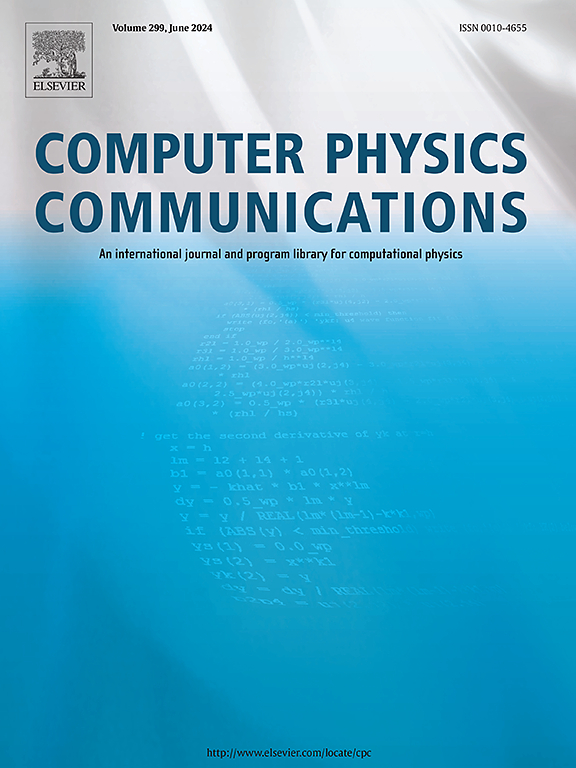A field-aligned gyrokinetic solver based on discontinuous Galerkin in tokamak geometry
IF 3.4
2区 物理与天体物理
Q1 COMPUTER SCIENCE, INTERDISCIPLINARY APPLICATIONS
引用次数: 0
Abstract
This paper presents the development of a hyperbolic solver for the gyrokinetic equation in tokamak geometry. The discontinuous Galerkin method discretizes the gyrokinetic equation on the field-aligned mesh composed of twisted prism-shaped elements in the tokamak domain. The elements are generated by extending the vertices of unstructured triangular elements on a poloidal plane following the equilibrium magnetic field lines. A sub-triangulation is employed to transfer information between nonconforming meshes, which is inevitable when implementing the field-aligned mesh. The numerical integrations of elements in the field-aligned mesh are performed by transforming the numerical integrations of reference elements in a reference element. We investigate the impact of field-aligned mesh on the numerical interpolation of synthetic plasma fluctuation data generated by a ballooning function. The numerical tests show that the field-aligned mesh can significantly improve computational efficiencies. Additionally, we estimate a sufficient condition for a stable temporal discretization of the hyperbolic solver based on a Runge-Kutta method. The estimation indicates that the field-aligned mesh can allow a notable increase of the time step size for stable simulation. In the numerical experiments, the solver shows good conservations of physical quantities such as mass, kinetic energy, and toroidal canonical angular momentum.
托卡马克几何中基于不连续伽辽金的场对准陀螺动力学求解器
本文介绍了托卡马克几何陀螺动力学方程双曲解的发展。用不连续伽辽金方法对托卡马克域中由扭曲棱镜组成的场向网格的陀螺动力学方程进行离散化。这些元素是通过沿着平衡磁场线在极向平面上扩展非结构化三角形元素的顶点而产生的。采用子三角剖分法在不一致网格之间传递信息,这在实现场对齐网格时是不可避免的。通过将参考单元的数值积分转换为参考单元的数值积分,实现了场对准网格中各单元的数值积分。研究了场对准网格对气球函数生成的合成等离子体波动数据数值插值的影响。数值试验表明,场对准网格能显著提高计算效率。此外,我们还利用龙格-库塔方法估计了双曲解的稳定时间离散化的充分条件。估计表明,场对准网格可以显著增加时间步长,以达到稳定模拟的目的。在数值实验中,求解器对质量、动能、环面正则角动量等物理量具有良好的守恒性。
本文章由计算机程序翻译,如有差异,请以英文原文为准。
求助全文
约1分钟内获得全文
求助全文
来源期刊

Computer Physics Communications
物理-计算机:跨学科应用
CiteScore
12.10
自引率
3.20%
发文量
287
审稿时长
5.3 months
期刊介绍:
The focus of CPC is on contemporary computational methods and techniques and their implementation, the effectiveness of which will normally be evidenced by the author(s) within the context of a substantive problem in physics. Within this setting CPC publishes two types of paper.
Computer Programs in Physics (CPiP)
These papers describe significant computer programs to be archived in the CPC Program Library which is held in the Mendeley Data repository. The submitted software must be covered by an approved open source licence. Papers and associated computer programs that address a problem of contemporary interest in physics that cannot be solved by current software are particularly encouraged.
Computational Physics Papers (CP)
These are research papers in, but are not limited to, the following themes across computational physics and related disciplines.
mathematical and numerical methods and algorithms;
computational models including those associated with the design, control and analysis of experiments; and
algebraic computation.
Each will normally include software implementation and performance details. The software implementation should, ideally, be available via GitHub, Zenodo or an institutional repository.In addition, research papers on the impact of advanced computer architecture and special purpose computers on computing in the physical sciences and software topics related to, and of importance in, the physical sciences may be considered.
 求助内容:
求助内容: 应助结果提醒方式:
应助结果提醒方式:


